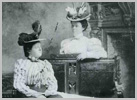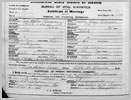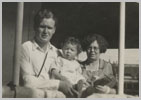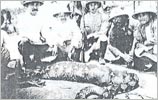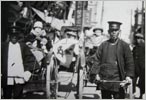
My journey ends here...
MONROE Della Mae
Born Della May HOGAN.
Also Della Mae Graves, Della Mae Grainger.
Date of birth : July 1, 1876, Brunswick County (Missouri).
Date of death : August 23, 1927, at the Norwalk State Hospital of Los Angeles (California).
Addresses
* 1904 : 2511 Folson Street, Los Angeles
* 1910 : 2440 Boulder
Street; 1114 East 10th Street, Los Angeles ( )
)
* 1912 : 324 bis South Hill Street, Los Angeles (at her second husband's home, Lyle Graves)
* 1916 : 26 Westminster Avenue, à Venice (California, South of Santa Monica)
* 1917-1920 : 1410 Coral Canal
Court, Venice; at Charles Grainger's home ( ).
).
1926 : 418 puis
206 East Rhode Island Street, Hawthorn (California) 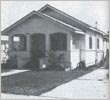 ,
,
Story
Her parents Tilford Marion Hogan and Jennie Nance, were native to Missouri.
She was the second on the 4 children.
The hard peasant life led the Hogans to the East of California in the 1890's.
Her parents separated from each other when she was aged 13; she spent the following years living alternately with one parent, then with the other one.
In 1898, she met Otis Elmer Monroe (May 14, 1866, Indiana-July 22, 1909, California), a house painter, recently disembarked from Indiana. He was 10 years elder than her. He aspired to go one day in Europe to study painting. He addes spice to his conversations about French painters and the Parisian Belle Epoque of which he had seen reproductions in magazines.
At the end of 1899, after a diligent wooing, Della married him.
The pictures of this era shows a woman, medium-size, with a face round and strong, dark eyes, kind of strict-jawed and a behaviour uncannily steady : a young bride without shyness.
There are no portraits of Otis, but Della described him light-skinned, red-haired and nut brown eyed.At the beginning, Della Mae was sad to have left the USA.
She often stood on her porch to better copntemplate the bridge, over the Rio Grande, which led to Texas.
But she knew how to adapt and soon felt comfortable in the role she had given herself : giving courses to the Indian and the Mexican women to who she occasionally used as a midwife.In Fall 1901, Della was pregnant.
On May 27, 1902 birth of Gladys Pearl.
She was declared to a civil Mexican judge 5 days later (Sunday, June 1st or Monday, June 2nd).
 ).
).
With such an instability and such a precariousness, the children Gladys
ans Marion, whitout being deprived of essentials, lived their first
years in insecurity; always on the move (as Della had been in her
childhood), they had no means to strike up friendships.
Otis often forgot to come home after his working day; when he came back, Della asked him where he had gone, and he invariably answered "I don't remember". Because he sometimes drank a lot, Della wasn't really surprised by his knowledge-gaps.
In 1908 Otis behaviour and health deteriorated with an alarming suddenness. His
memory became capricious, his answers often irrelevant, he suffered
from violent headaches and his dress became more and more neglected.
Summer 1908 Otis became half-paralysed.
In November 1908 he entered the Southern California State Hospital, in Patton (San Bernardino County)
A general paresis was diagnosed, final level of nervous syphilis (the treatment of this illness was only discovered in 1908).
This would mean that, in opposition to many interpretations, his mental illness was due to an incidental pathology and not to a hereditary illness.
Della often visited him at the hospital but only during the first months.Then, he sank into a complete dementia; he didn't recognize her anymore.
Because she had to provide for her family, she had started to work.
On July 22, 1909, whitout having left his hospital bed for 9 months, Otis died. He was aged 43.
Terrified, maybe, by her husband's dazzling mental decline, Della told her children that their father had became insane, maybe because of alcohol, maybe because of his wild life.
However, the medical records given to her after Otis death, clearly explains that he died from an organic illness and not from a mental one.
Della, Gladys and Marion were, regardless, intimately convinced that their husband and father, who died of an infection which had destroyed his nerve cells, had died of madness.
Della started to have a very dignified behavior, a melancholy combined with stoicism. She conscientiously worked and attended, with her children, one of the close Protestant church, "to pray for the health of their own mind". Despite this transitional excess of piety, she had kept all the exuberance and the impetuosity of her youth (she was only aged 33).
In 1910 she received the best single men and widowers in her house of 2440 Boulder Street.
In 1910 and 1911 Della got engaged several times before decide on a new husband.
She quickly met Lyle Arthur Graves, aged 39 ans, a shy and hardworking man.
Native to Green Bay (Wisconsin), he had worked at the Pacific Electric with Otis. From then, he was chief switchman.
On March 7, 1912 she got married Lyle Arthur
Graves (March 24, 1882, Wisconsin-March 1st, 1968, Ohio)
The family settled in Graves's house, located 324 bis South Hill Street, in the new part of the Los Angeles business district.
Soon, Della realized her mistake : Lyle had too, a distinct tendency for alcohol and had a violent temper.
In November 1912 she left the marital home with her two children, and lived in a furnished apartment.For Christmas 1912 she went back to Graves home, apparently because she had no more resources.
But despite the gifts Lyle gave to the children, the reconciliation didn't last long.
Graves had even given to Della the management of his own salary.
In May 1913 Della left
Graves for good.
On January 17, 1914 the divorce was granted. Della accused Graves of "not having guarantee her the material support, debauchery and chronic untemperance".
End of 1916 she hired a room in a familiy hotel, 26 Westminster Avenue in Venice (California, south of Santa Monica). The owner of the family hotel was named Jasper Baker and he hired her to manage his property while he dealt with a gaming place on the beach.
She sent her son Marion, aged 11, to live at her cousins home in San Diego; Della thought that a boy should be raised by a man.
The following days, he visited her almost every evening, at Westminster Avenue.
To Della, Grainger's life was more exotic than what Otis Monroe could have dreamt of. He worked in the oil industry.
He lived not far from her at 1410 Coral Canal Court, in an humble two-rooms bungalow which overlooked one of the many canals of Venice. It was quite a charming address and when she discovered it, Della succombed to its charm.
Living together without being married was not much tolerate at this era than abortion or divorce, but, nevertheless, Charles and Della had a close look at the idea of sharing Coral Canal Court.Della made her simply called Mrs Grainger and everyone fell for it.
Charles job prospects were more than uncertain and he hoped new contracts abroad.Furthermore, he had to provide for his two sons remained in the north of California.
He shouldn't have been very keen by the idea of being legally responsible for Della and her daughter's support.
Both discreet before this new father and frustrated to see her mother living a situation which irregularity didn't give her any emotional stability, Gladys wasn't happy. She showed it to Grainger by being in an absolute silence and bad humor. Della began to find her daughter irritating and moreover, the offer of Charles Grainger to live with him was still expected.
On May 17, 1917 Gladys married John Newton Baker.
Della Monroe declared that her daughter was aged 18 (but in fact she was hardly 15) under the pretext that there were no real proofs of her real date of birth, because they had recently moved in from Oregon to California.
Della, smiley, attended to the wedding
then gave to the young grooms the room located at Westminster Street,
and quickly moved in Charles Grainger bungalow.
In 1918 Charles Grainger found a job not in oil, but as manager of the Pickering Pleasure Pier of Santa Monica, where he had a regular salary.
Della's relationships with her former husbands having been very disturbed she often lived separate from Charles Grainger, for days or even weeks.Della with her grand-chidren  -
-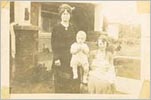 -
- ,
,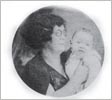 -
- ;
;
1921 or March 1922, Della was back to Charles Grainger's home, then she left him once again.
Gladys left the marital home and rented a bungalow located 46
Rose Avenue, in Venice, she shared with her mother.
Gladys signed the lease in the name of
Della Monroe, where she agreed to sublet two of the rooms, to be paid
as manager and to deposit 100$ a month to the owners, Adele Weinhoff
and Susie Noel.
End of June 1922, the last rent-check hadn't been mailed. Then, there was an argument between Gladys and Della, blaming each other to waste the money. Because both of them hadn't any job, the main part of their income was given by Charles Grainger, the other part consisting of a small amount sent by Jasper Baker.
Their short room-mates experience ended in July, after an eviction threat.
Della, with Grainger's permission, went to live in an empty bungalow he owned in Hawthorn (working-class suburb, now the Los Angeles International Airport).
In 1924 Marion got married with one of his classmates, Olyve Brunnings.
Gladys got married with Martin Mortensen on October 11, 1925, and meft her several months later.
End of 1925, Gladys learned she was pregnant.
Separated from his husband and emmeshed in the divorce formalities, she went back to her mother's home to have some support.
Della reacted badly to her daughter's situation; she ignored her daughter's wails and crying and went to a trip in South-East Asia she had scheduled for a long time, with Charles Grainger, who had been sent there by Shell company for professionnal reasons.
On February 24, 1926 Della apllied for a passport, for her journey to Borneo scheduled on March 30, 1926
On this request, the date of the wedding between Della and Charles
Grainger was stipulated as November 25, 1920.
On May 27, 1926 she sent a postcard from Borneo to her grand-children Berniece and Robert Baker, who lived with their father in Kentucky. She didn't seem to know that the children hadn't any news of their mother, Gladys
The caption is : "Dear Little Berniece, This is kind of big snakes they have here. They are big enough they could swallow you and Jackie and so could the alligators. They have lots of fun here hunting them. This is your mother's birthday. Do you and Jackie ever write to her, write to me. Your grand mother Mrs Chas. Grainger".
June 1926, when Della Monroe discovered that her grand-daughter, two weeks after her birth, she urged Gladys to foster her to a serious and devoted couple, the Bolenders, who lived Hawthorn, in the same street than hers. They looked after the little girl for 7 years.
Della and Norma Jeane -
-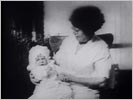
As many families of this era, the Bolenders supplemented their income by taking care of a child. To shoulder this responsability, they were paid 25$ a month or by the natural parents either by the State of California.
Della had become a devoted disciple of Sister Aimee Semple Mc Pherson and made Norma Jeane baptized on
December 6, 1926 at the Hawthorn
Foursquare Church (4503 then 4511 West Broadway à Hawthorn) 
At the beginning of 1927, her heart began to get weaker and she often suffered from respiratory infections.
She was completely dependent on Gladys, who, in spite of her extra trolley transport to go to her work, had moved in her mother's home.End of spring, Della was in bad condition; her respiratory problems were worsened by her heart disease evolution, which dropped her in a deep nervous breakdown.
The drugs only allayed her occasionally.
Between the intervals, as many sick people affected by cardio-respiratory problems, she drifted in pleasant reveries, delirium and some moments of total exhilaration. Gladys couldn't keep her from thinking of the whimsical behaviour of her father, during his last years.
Gladys couldn't keep her from thinking of the whimsical behaviour of her father, during his last years.
At that time, she would have had an attack which may have been the source of her unpredictable mood swings.July 1927, Della was convinced that it was the end of her life. The guiltiness and the memories alternated with hallucinations : her parents, Tilford and Jenny Hogan had buried the hatchet, she told Gladys. They would rescue her and bring her back to her home.
Shortly after, she get out of her house and walked toward the Bolenders house to see her grand-daughter.
She beat at the door then angry not to obtain an answer, she broke the window glass with her elbow.
August 4, 1927, she was admitted to the Norwalk State Hospital where an acute myocarditis was diagnosed.
She died on August 23,1927 ( ) of a heart failure during a insane attack, that Gladys, then Marilyn herself, would consider as an inherited malediction.
) of a heart failure during a insane attack, that Gladys, then Marilyn herself, would consider as an inherited malediction.
Gladys dealt with the funeral and made Della buried next to her first husband, Otis Elmer Monroe, at the Rose Hill
As cause of death, her certificate mentioned a myocarditis and also "a manic-depressive psychosis"
 . This last word had been added because
Gladys hadn't ceased to repeat to the Norwalk State Hospital doctors
that her mother mood had varied in an unexpected way during the last
weeks.
. This last word had been added because
Gladys hadn't ceased to repeat to the Norwalk State Hospital doctors
that her mother mood had varied in an unexpected way during the last
weeks.
Della's severe cardiac disease had been in fact, very badly treated.
The doctors had just examined her 3 or 4 times, and she even herself
forgot the drugs doses she had to take.
Gladys assertions about her mother mental condition explained that the
notion of psychosis had been added when, the day after Della's death,
the person in charge signed the death certificate.
As for her husband, Otis Monroe, nothing proves that she had been insane, but for Gladys, the familial insanity myth was being consolidated.
 BACK TO INDEX
NEXT FILE
BACK TO INDEX
NEXT FILE
